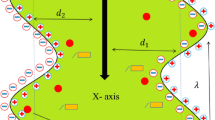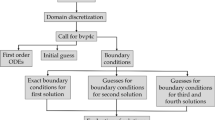Abstract
A mathematical model, including electromagnetic field equation, fluid flow equation, and temperature field equation, was established for the simulation of the electroslag remelting process. The distribution of temperature field was obtained by solving this model. The relationship between the local solidification time and the interdendritic spacing during the ingot solidification process was established, which has been regarded as a criterion for the evaluation of the quality of crystallization. For a crucible of 950 mm in diameter, the local solidification time is more than 1 h at the center of the ingot with the longest interdendritic spacing, whereas it is the shortest at the edge of the ingot according to the calculated results. The model can be used to understand the ESR process and to predict the ingot quality.
Similar content being viewed by others
Abbreviations
- C1, C2:
-
Constants in к-ε model
- C d :
-
Dissipation rate constant
- c P :
-
Specific heat
- d:
-
Interdendritic spacing, m
- G:
-
Generation term for turbulence kinetic energy
- g:
-
Gravitational acceleration, (m · −2)
- H:
-
Magnetic field intensity, (A · m−1)
- H̑:
-
Complex amplitude of H
- H̑r, H̑rθ, H̑rz:
-
Magnetic field intensity in r, θ, and z direction, respectively
- h sw :
-
Overall heat transfer coefficient between slag and cooling water, (W · m−2 · K−1)
- h/w,i:
-
Heat transfer coefficient of other position, (W · m−2 · K−1)
- I 0 :
-
Reference value of current, A
- J:
-
Current intensity, (A · m−1)
- J̑:
-
Complex amplitude of J
- J̑r:
-
Complex conjugation of J̑
- k1, k2:
-
Coefficient, depending on steel grade
- k eff :
-
Effective thermal conductivity, (W · m−1 · K−1)
- Q s :
-
Rate of heat extraction from slag by metal droplets
- q r :
-
Radiant heat loss, J
- R:
-
Radius, m
- r:
-
Radial coordinate, m
- T:
-
Temperature
- t:
-
Time, s
- v c :
-
Solidification rate of ingot, (m · h−1)
- vr, vz:
-
Velocity of r and z direction, (m · h−1)
- z:
-
Axial coordinate, m
- zs, zL:
-
Position of solidus and liquidus, m
- β:
-
Coefficient of thermal expansion of slag
- ξ:
-
Vorticity
- ψ:
-
Stream function
- к:
-
Kinetic energy of turbulence
- ε:
-
Dissipation rate of turbulence energy
- ρ:
-
Density, (kg · m−3)
- σ:
-
Electrical conductivity, (Ω−1 · m−1)
- ω:
-
Angular frequency of current, (rad · s−1)
- μ:
-
Viscosity of slag, (Pa · s−1)
- μ0:
-
Magnetic permeability, (H · m−1)
- μeff:
-
Effective viscosity, (Pa · s−1)
- μt:
-
Turbulent viscosity
- e:
-
Electrode
- i:
-
Ingot
- L:
-
Metal pool
- m:
-
Mushy zone
- s:
-
Liquid slag
References
Ballantyne A S, Mitchell A. Modelling of Ingot Thermal Fields in Consumable Electrode Remelting Processes [J]. Ironmaking and Steelmaking, 1977, 4(4): 222–239.
Choudhary M, Szekely J. Modeling of Profiles, Temperature Profiles and Velocity Fields in ESR Systems [J]. Metallurgical Transactions, 1980, 11B(3): 439–453.
Kelkar K M, Mok J, Patankar S V, et al. Computational Modeling of Electroslag Remelting Processes [J]. Journal de Physique IV, 2004, 120: 421–428.
Dilawari A H, Szekely J. Heat Transfer and Fluid Flow Phenomena in Electroslag Refining [J]. Metallurgical Transactions, 1978, 9B(3): 77–87.
Dilawari A H, Szekely J. A Mathematical Model of Slag and Metal Flow in the ESR Process [J]. Metallurgical Transactions, 1977, 8B(2): 227–236.
Hernandez-Morales B, Mitchell A. Review of Mathematical Models of Fluid Flow, Heat Transfer, and Mass Transfer in Electroslag Remelting Process [J]. Ironmaking and Steelmaking, 1999, 26(6): 423–438.
JIANG Zhou-hua. Mathematical Simulation and Experiment Analysis of Thermal Transfer for ESR [D]. Shenyang, China: Northeastern University Press, 1986 (in Chinese).
WEI Ji-he, REN Yong-li. Mathematical Simulation of Magnetic Field in ESR System [J]. Acta Metallurgica Sinca, 1995, 31 (2): 51–60 (in Chinese).
WEI Ji-he, REN Yong-li. Mathematical Modeling of Slag Flow Field in ESR System [J]. Acta Metallurgica Sinca, 1994, 30 (11): 481–490 (in Chinese).
FU Jie, CHEN Chong-xi, CHEN En-pu, et al. Temperature Distribution Round the Molten Slag Pool in the Process of Electroslag Refining [J]. Acta Metallurgica Sinca, 1979, 15 (1): 44–50 (in Chinese).
Author information
Authors and Affiliations
Corresponding author
Additional information
Foundation Item: Item Sponsored by Weaponry Pre-Research Fund (51412020304QT090l)
Rights and permissions
About this article
Cite this article
Dong, Yw., Jiang, Zh. & Li, Zb. Mathematical Model for Electroslag Remelting Process. J. Iron Steel Res. Int. 14, 7–12 (2007). https://doi.org/10.1016/S1006-706X(08)60042-4
Revised:
Published:
Issue Date:
DOI: https://doi.org/10.1016/S1006-706X(08)60042-4




